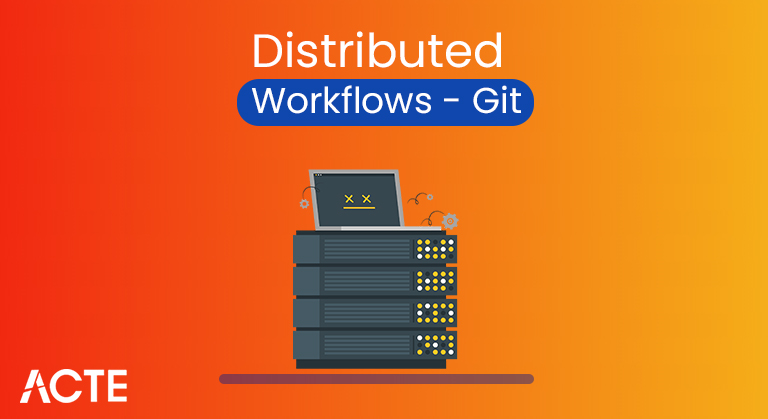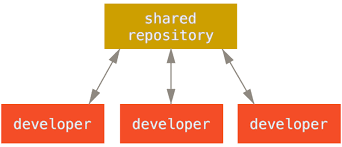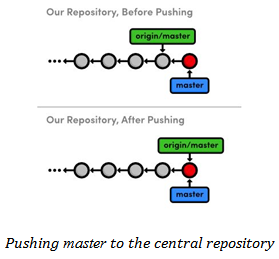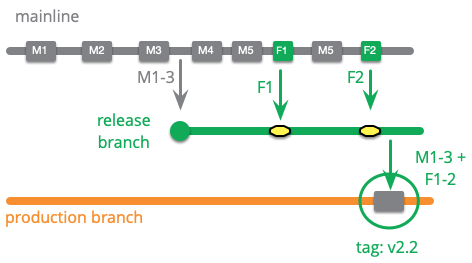
Distributed Workflows :-
Unlike centralised version control systems (CVCS), the distributed nature of allows you to be far more flexible in how developers collaborate on projects. In centralised systems, each developer is a node working more or less uniformly with a central hub. However, each developer is potentially both a node and a hub; That is, each developer can contribute code to other repositories and maintain a public repository on which others can base their work and contribute to it. This presents a wide range of workflow possibilities for your project and/or your team, so we will cover some common paradigms that take advantage of this flexibility. We will consider the strengths and potential weaknesses of each design; You can choose one to use, or you can mix and match features from each.

Centralised Workflow :-
In centralised systems, there is usually a single collaboration model–centralised workflow. A central hub, or repository, can accept code, and everyone synchronises their work with it. Multiple developer nodes are—users—of that hub and sync with that centralised location.This means that if two developers clone from the hub and both make changes, the first developer can do so without a problem having to back up their changes. The second developer needs to merge the changes into the earlier work before the changes can be pushed forward, so as not to overwrite the first developer’s changes. This concept is as true in as it is in Subversion (or any CVCS), and it works perfectly well in model.

If you are already comfortable with a centralised workflow in your company or team, you can easily continue using that workflow with. Simply set up a single repository, and give push access to everyone on your team;Won’t let users overwrite each other.
Suppose both John and Jessica start working at the same time. John completes his change and pushes it to the server. Then Jessica tries to push her changes, but the server rejects them. She has been told that she is trying to push non-fast-forward changes and will not be able to do so until she has received and merged. This workflow is appealing to many people because it is a paradigm that many are familiar with and comfortable with. It is also not limited to small teams. With the branching model of, it is possible for hundreds of developers to work successfully through dozens of branches simultaneously on a single project.
Dictator and Lieutenants Workflow :-
It is a variant of a multi-store workflow. It is commonly used by large projects with hundreds of collaborators; A well-known example is the Linux kernel. Various integration managers are in charge of parts of the repository; He is called a lieutenant. All lieutenants have an integration manager known as a benevolent dictator. The liberal dict pushes from its directory to a reference repository from which all peers need to be pulled. The process works like this (see Benevolent Dictator Workflow):
Regular developers work on their topic branch and redo their work on top of master. The master branch is the reference repository to which the dict pushes.Lt merges the subject branches of developers into their master branch.The dictator merges the lieutenant’s master branches into the dictator’s master branch.Finally, dict pushes that master branch to the reference repository so that other developers can revisit it.
Benevolent dictator workflow and Liberal dictator workfloW is not common, but can be useful in very large projects, or in highly hierarchical environments. This allows the project leader (dictator) to collect large subsets of code at several points before delegating a lot of tasks and integrating them.
- Martin Fowler has created a guide “Patterns for Managing Source Code Branches”. This guide covers all common workflows, and explains how/when to use them. There is also a section comparing high and low integration frequencies.
- These are some of the more commonly used workflows that are possible with a distributed system like, but you can see that there are many variations possible to suit your particular real-world workflow. Now that you can (hopefully) determine which workflow combination might work for you, we’ll cover some more specific examples of how to accomplish the key roles that make up the different flows. In the next section, you’ll learn about some common patterns for contributing to a project.
Patterns for Managing Source Code Branches

What is a successful Git workflow?
The most commonly used version control system today. A Workflow is a recipe or recommendation on how to use to get the job done in a consistent and productive manner. Workflows encourage developers and DevOps teams to leverage effectively and consistently. Provides great flexibility in how users handle changes. Given’s focus on flexibility, there is no standardised process on how to interact with.-When working with a team on a managed project, it is important to ensure that the team all agree on how the flow of changes will be implemented. To ensure that the team is on the same page, an agreed workflow must be developed or selected. There are many hyped workflows that may be a good fit for your team. Here, we will discuss some of these workflow options.
The array of possible workflows can make it hard to know where to start when implementing in the workplace. This page provides a starting point by surveying the most common workflows for software teams. As you read, remember that these workflows are designed to have guidelines rather than concrete rules. We want to show you what’s possible, so you can mix and match aspects of different workflows to suit your individual needs.
However, using to power your development workflow offers some advantages over SVN. First, it gives each developer their own local copy of the entire project. This isolated environment lets each developer work independently of all other changes to a project – they can add commits to their local repository and completely forget about upstream development unless it’s convenient for them. Ho.
Second, it gives you access to a robust branching and merging model of. Unlike SVN, branching is designed as a fail-safe mechanism for integrating code and sharing changes between repositories. Centralised workflows are similar to other workflows in their use of a remote server-side hosted repository that developers push and pull. Compared to other workflows, there is no defined pull request or forking pattern in a centralised workflow. A centralised workflow is generally better suited for teams migrating from SVN to and smaller sized teams.
- Modify files in the working directory.
- Note that any file you change becomes a file in the modified state.
- Selectively stage the files you want to be in the directory.
- Note that any file you stage (add) to the staging area becomes a staged file.
- Also, be aware that the staged files are not in the database yet.
- Staging means that the information about the staged file is included in a file (called an “index”) in the repository.
- Submit the files that you have placed in the directory. That is, store the snapshot of the staged file(s) permanently in the database.
- Note that any file version you commit to the directory becomes a file in the commit state.
- The long and short of all the discussions so far have been that is a great version control system for capable versioning, management and distribution of files. Check out this simple guide to learn how to use it efficiently.
Integration Branch :-
Use an integration branch with software development teams that work as a unit toward deploying a collection of contributions to production. This is as opposed to inhibiting your ability to release what is ready.
GitHub Demystified :-
GitHub is a web-based platform where users can host repositories. It helps you easily share and collaborate on projects with anyone at any time. GitHub encourages wider participation in open-source projects by providing a secure way to edit files in another user’s repository. To host (or share) a repository on GitHub, follow the steps below:
Step 1: Sign up for a GitHub account
The first step in starting hosting on GitHub is to create a personal account. To sign up visit the official registration page.
Step 2: Create a Remote Repository in GitHub
After signing up for an account, create a home (a repository) in GitHub for the repository you want to share.
Step 3: Connect the project’s directory to the remote repository
Once you’ve created a remote repository for your project, link the project’s directory—located locally on your system—to the remote repository on GitHub.
- Replace your username with your GitHub username in the above code.
- Similarly, replace your reponame with the name of the remote repository you want to connect to.
- The above command implies that should add the specified URL to the local project as a remote context with which the local directory can interact.
- The basic option in the command above is the default name (an abbreviation) given to the server hosting your remote repository.
- That is, instead of the URL of the server, uses the short name origin.
- It is not mandatory to stick with the default name of the server. If you prefer a different name instead of the original one, simply replace the original name with any name you like in the remote add command above.
- Always remember that the server’s abbreviation (eg, original) is nothing special! It only exists – locally – to help you easily reference the URL of the server. So feel free to change it to an abbreviation that you can easily refer to.
- To rename any existing remote URL, use theremote rename command:Rename remoteCurrentURLName yourNewURLName
- Whenever you clone (download) a remote repo, automatically names the URL origin of that repo. However, you can specify a different name with the clone – on yourPreferredName command.
- The above command implies that should push your local master branch to the remote master branch located at the URL of the origin name.
- Technically, you can replace the origin option with the URL of the remote repository. Remember, the native option is just an alias of the URL that you have registered in your local directory.
- The -u flag (upstream/tracking context flag) automatically links the local branch of the directory to the remote branch. This allows you to use a bridge without any arguments.
To connect to a remote repository, go inside the root directory of the project you want to share via your local terminal, and run: Remote Add Origin https://github.com/yourusername/yourreponame pay attention:
- This is a version control system used to track changes to computer files. It is commonly used for source code management in software development.
- Distributed version control tools used for source code management
- It allows multiple developers to work together
- It supports non-linear development through its thousands of parallel branches.
Conclusion




